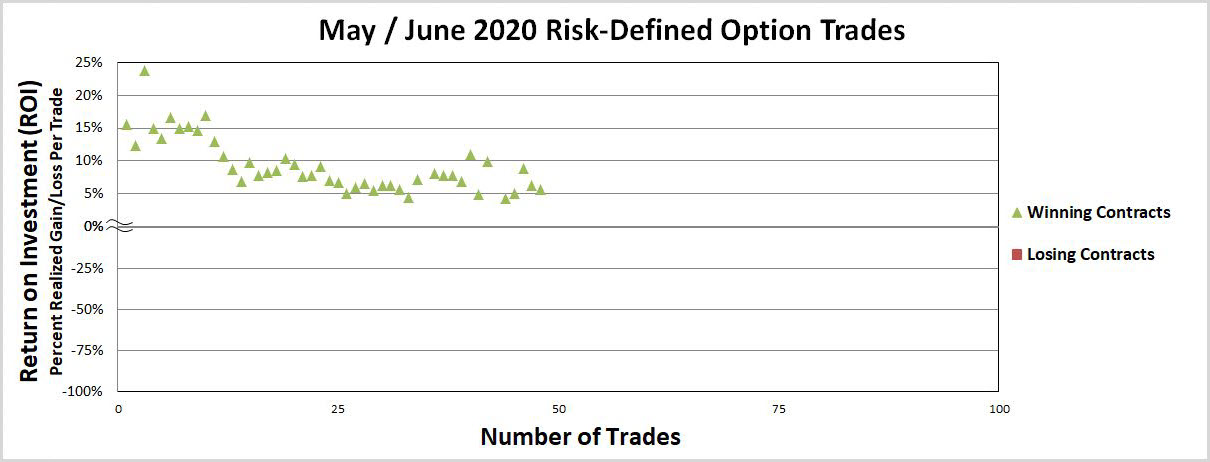Balancing the trade-offs between risk and reward is front and center even as the markets recover from the depths COVID-19 induced sell-off. Options trading can offer the right balance between risk and reward while providing a margin of downside protection and a statistical edge. Proper portfolio construction and optimal risk management are essential when engaging in options trading as the main driver for portfolio results. One of the main pillars when building an options-based portfolio is maintaining a significant portion of cash-on-hand. This cash position provides the ability to rapidly adapt when faced with extreme market conditions such as COVID-19 and Q4 2018 sell-offs. The COVID-19 pandemic is a prime example of why maintaining liquidity, risk-defining trades, staggering options expiration dates, trading across a wide array of uncorrelated tickers, maximizing the number of trades, appropriate position allocation and selling options to collect premium income are keys to an effective long-term options strategy.
Minimizing Risk and Maximizing Return
Leveraging a minimal amount of capital and maximizing returns with risk-defined trades optimizes the risk-reward profile. Whether you have a small account or a large account, a defined risk (i.e., put spreads and diagonal spreads) strategy enables you to leverage a minimal amount of capital which opens the door to trading virtually any stock on the market regardless of share price such as Apple (AAPL), Amazon (AMZN), Chipotle (CMG), Facebook (FB), etc. Risk-defined options can easily yield double-digit realized gains over the course of a typical one month contract (Figures 1, 2, and 3).

Figure 1 – Average income per trade of $184, the average return per trade of 7.4% and 95% premium capture over 38 trades in May and June

Figure 2 – Options win rate of 100% across 23 unique tickers using put spreads and diagonal spreads with an average length of each trade coming in at 13 days

Figure 3 – Average return on investment (ROI) per trade of 8.2% using a risk defined strategy via leveraging a minimal amount of capital to maximize returns
An Effective Long-Term Options Strategy
Risk management is paramount when engaging in options trading. A slew of protective measures should be deployed if options are used as a means to drive portfolio results. When selling options and running an options-based portfolio, the following guidelines are essential (Figures 4 and 5):
-
1. Trade across a wide array of uncorrelated tickers
- 2. Maximize sector diversity
- 3. Spread option contracts over various expiration dates
- 4. Sell options in high implied volatility environments
- 5. Manage winning trades
- 6. Use defined-risk trades
- 7. Maintains a ~50% cash level
- 8. Maximize the number of trades, so the probabilities play out to the expected outcomes
- 9. Continue to trade through all market environments
- 10. Appropriate position sizing/trade allocation

Figure 4 – A composite of ~75 tickers that can be used as a means to trade uncorrelated tickers across diverse sectors

Figure 5 – Trade notification service example of a trade cluster that expired on a Friday
Diagonal Put Spreads
Options are a leveraged vehicle; thus, minimal amounts of capital can be deployed to generate outsized gains with predictable outcomes. A diagonal put credit spread strategy is an ideal way to balance risk and reward in options trading. This strategy involves selling a put option and buying a put option while in the process, collecting a credit. When selling the put option, a premium is collected and simultaneously using some of that premium income to buy a further dated put option at a lower strike price. The net result will be a credit on the pair trade with defined risk since the purchase of the put option serves as protection.
Getting started is easy! Test our tools with a 30-day trial.
The required capital is equal to the maximum loss, while the maximum gain is equal to the option premium income received. If a put option is sold at a strike price of $100 and another put option is purchased at a strike of $95, then the max loss is strike width of $5 per share or $500 less the net premium received. Since the risk-defined approach has a max loss, the required capital is equivalent to the max loss. If the premium collected was $75, then the required capital would be $425, and at the expiration of the contact, an ROI of 18% is obtained for a winning trade.

Figure 6 – Fundamentals of options trading, 10 rules for long-term successful options trading results
Conclusion
Options are a leveraged vehicle; thus, minimal amounts of capital can be deployed to generate outsized gains with predictable outcomes. A diagonal put credit spread strategy is an ideal way to balance risk and reward in options trading. The COVID-19 black swan event reinforces why appropriate risk management is essential while holding cash-on-hand. The overall options-based portfolio strategy is to sell options that enable you to collect premium income in a high-probability manner while generating consistent income for steady portfolio appreciation despite market conditions. This options-based approach provides a margin of safety while mitigating drastic market moves and containing portfolio volatility.
Options trading is a long-term game that requires discipline, patience, and time. The COVID-19 black swan event reinforces why keeping liquidity, spreading out expiration dates, maximizing sector exposure, maximizing ticker diversity, risk-defining trades, and continuing to sell options through all market conditions is essential. Continuing to stick to the fundamentals with defined risk trades via leveraging small amounts of capital to maximize profits is essential. Keeping a significant portion of your portfolio in cash is essential to the overall strategy.
Thanks for reading,
The INO.com Team
Disclosure: The author holds shares in AAPL, AMZN, DIA, GOOGL, JPM, MSFT, QQQ, SPY and USO. The author has no business relationship with any companies mentioned in this article. This article is not intended to be a recommendation to buy or sell any stock or ETF mentioned.
